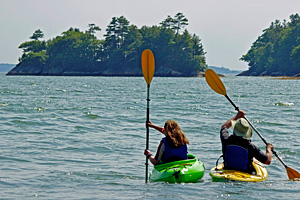Climate Adaptation and Estuaries

EPA works with local, state and federal governments as well as the 28 National Estuary Programs to improve and maintain the waters, habitats and living resources of estuaries across the country. An estuary is a partially enclosed, coastal water body where freshwater from rivers and streams mixes with salt water from the ocean.
Climate changes including rising sea levels, altered rain patterns, drought, and ocean acidification threaten to degrade estuaries.
Rising sea levels will move ocean and estuarine shorelines by inundating lowlands, displacing wetlands, and altering the tidal range in rivers and bays. Storm surges resulting from more extreme weather events can increase the areas subject to periodic inundation.
Increased frequency and intensity of rainfall can lead to greater stormwater runoff, erosion, and sedimentation. Greater nutrient, pollution or sediment introduction in an estuary can threaten estuarine ecosystem function.
Conversely, decreased precipitation can also affect the salinity of coastal waters. Estuaries require a natural balance of freshwater and saltwater. Droughts reduce fresh water input into tidal rivers and bays, which raises salinity in estuaries, and enables salt water to mix farther upstream. The increase of salinity in brackish water environments can threaten to degrade ecosystem health. The intrusion of saltwater within groundwater or further upstream also poses risks for coastal drinking water infrastructure.
The rising concentration of carbon dioxide (CO2), and subsequent absorption in the ocean, leads to marine waters becoming more acidic. Increased acidity of ocean and coastal waters can threaten to reduce the availability of certain minerals in seawater that are needed to build and maintain coral skeletons and support other estuarine species such as shellfish. Ocean acidification in combination with other stressors can lead to greater coral reef die-off and threaten aquatic life, threatening the success of coastal estuary programs. For more on Ocean Acidification see the EPA’s Ocean Acidity webpage.
